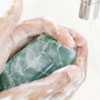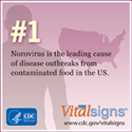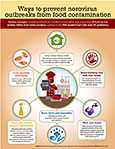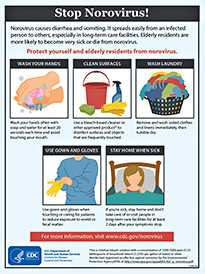Preventing Norovirus Infection
Español: Cómo prevenir las infecciones por norovirus
There is no vaccine to prevent norovirus infection, but research is being done in this area.
Practice proper hand hygiene
Wash your hands carefully with soap and water—
- especially after using the toilet and changing diapers, and
- always before eating, preparing, or handling food.

Noroviruses can be found in your vomit or stool even before you start feeling sick. The virus can stay in your stool for 2 weeks or more after you feel better. So, it is important to continue washing your hands often during this time.
Alcohol-based hand sanitizers can be used in addition to hand washing. But, they should not be used as a substitute for washing with soap and water. See “Handwashing: Clean Hands Save Lives.”
Have You Ever Heard of Norovirus?
Running Time: 2:37
Released Date: Dec 2015
This short video explains what norovirus is, how it spreads, and how you can protect yourself and loved ones from getting it.
Wash fruits and vegetables and cook seafood thoroughly
Carefully wash fruits and vegetables before preparing and eating them. Cook oysters and other shellfish thoroughly before eating them.
Be aware that noroviruses are relatively resistant. They can survive temperatures as high as 140°F and quick steaming processes that are often used for cooking shellfish.
Food that might be contaminated with norovirus should be thrown out.
Keep sick infants and children out of areas where food is being handled and prepared.
When you are sick, do not prepare food or care for others who are sick
You should not prepare food for others or provide healthcare while you are sick and for at least 2 days after symptoms stop. This also applies to sick workers in settings such as schools and daycares where they may expose people to norovirus.
Many local and state health departments require that food workers and preparers with norovirus illness not work until at least 48 hours after symptoms stop. If you were recently sick, you can be given different duties in the restaurant, such as working at a cash register or hosting.
Clean and disinfect contaminated surfaces
After throwing up or having diarrhea, immediately clean and disinfect contaminated surfaces. Use a chlorine bleach solution with a concentration of 1000–5000 ppm (5–25 tablespoons of household bleach [5.25%] per gallon of water) or other disinfectant registered as effective against norovirus by the Environmental Protection Agency (EPA). For more information, see EPA’s Registered Antimicrobial Products Effective Against Norovirus (Norwalk-like virus) [3 pages].
Note: Evidence for efficacy of a cleaning agent against norovirus is usually based on studies using feline calicivirus (FCV)—a virus related to norovirus—as a surrogate. However, FCV and norovirus exhibit different physiochemical properties; thus, it is unclear whether inactivation of FCV by a specific cleaning agent reflects efficacy of such solutions against norovirus.
Wash laundry thoroughly
Immediately remove and wash clothes or linens that may be contaminated with vomit or stool (feces).
You should
- handle soiled items carefully without agitating them,
- wear rubber or disposable gloves while handling soiled items and wash your hands after, and
- wash the items with detergent at the maximum available cycle length then machine dry them.
Resources
- CDC Vital Signs — Preventing Norovirus Outbreaks, Food Service has a Key Role
- Downloadable posters in English, Spanish, French, and a language-neutral pictogram version. The posters are a product of a collaboration of Somerset County (NJ), Department of Health; City of Albuquerque Environmental Health Department; National Environmental Health Association; Water Quality and Health Council; and American Chemistry Council.
- Updated Norovirus Outbreak Management and Disease Prevention Guidelines (2011)
- Guideline for the Prevention and Control of Norovirus Gastroenteritis Outbreaks in Healthcare Settings, 2011
- Norovirus Illness: Key Facts [2 pages]
- Norovirus: Facts for Food Workers [2 pages]
- Norovirus in Healthcare Facilities Fact Sheet [2 pages]
- Norovirus in Healthcare Settings
- A Norovirus Outbreak Control Resource Toolkit for Healthcare Settings
- EPA’s Registered Antimicrobial Products Effective Against Norovirus (Norwalk-like virus) [3 pages]
- Page last reviewed: June 24, 2016
- Page last updated: July 15, 2016
- Content source:




 ShareCompartir
ShareCompartir
